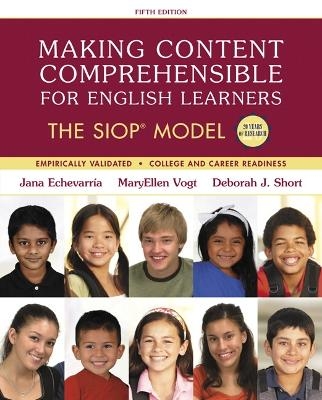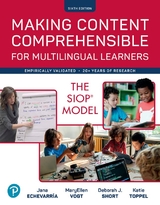
Making Content Comprehensible for English Learners
Pearson (Verlag)
978-0-13-404523-8 (ISBN)
- Titel erscheint in neuer Auflage
- Artikel merken
Using a writing style that is practical and applicable to all kinds of classrooms, this widely popular book presents a user-friendly approach for planning and implementing lessons for teaching English learners and other students. It provides students with access to grade-level content, develops their academic English skills, and prepares them to be college and career ready. The SIOP model is a comprehensive, coherent, research-validated, success-proven model for improving teaching effectiveness and ensuring academic gains for students. It can be implemented in all content areas at all grade levels and English proficiency levels. Making Content Comprehensible for English Learners provides specific application of the SIOP to the Common Core and other state standards and includes a Reflect and Apply eText feature in which readers explain their rating of teachers’ lessons, and Teaching with Technology vignettes that describe how to infuse technology into many different SIOP lessons. The Enhanced Pearson eText features new video links inserted throughout to illustrate chapter topics and discussion points. Check for Understanding and end-of-chapter quizzes provide a comprehensive means for gauging student understanding.
Improve mastery and retention with the Enhanced Pearson eText*
The Enhanced Pearson eText provides a rich, interactive learning environment designed to improve student mastery of content. The Enhanced Pearson eText is:
Engaging. The new interactive, multimedia learning features were developed by the authors and other subject-matter experts to deepen and enrich the learning experience.
Convenient. Enjoy instant online access from your computer or download the Pearson eText App to read on or offline on your iPad® and Android® tablet.*
Affordable. The Enhanced Pearson eText may be purchased stand-alone for 50-60% less than a print bound book.
*The Enhanced eText features are only available in the Pearson eText format. They are not available in third-party eTexts or downloads.
*The Pearson eText App is available on Google Play and in the App Store. It requires Android OS 3.1-4, a 7” or 10” tablet, or iPad iOS 5.0 or later.
Jana Echevarría, Ph.D., is Professor Emerita at California State University, Long Beach where she was selected as Outstanding Professor. She has taught in elementary, middle, and high school in general education, special education, ESL, and bilingual programs. An internationally known expert on second language learners, she has lived and worked in Taiwan, Mexico, and Spain. Her research and publications focus on effective instruction for English learners, including those with learning disabilities. She has presented her research across the U.S. and internationally including Oxford University (England), Wits University (South Africa), Harvard University (U.S.), Stanford University (U.S.), University of Barcelona (Spain) and South East Europe University (Macedonia) where she was a Fulbright Specialist. A founding researcher of the SIOP Model her publications include multiple books, book chapters and journal articles. MaryEllen Vogt, Ed.D., is Professor Emerita of Education at California State University, Long Beach. Dr. Vogt, a former classroom teacher, reading specialist, curriculum coordinator, and teacher educator, received her doctorate from the University of California, Berkeley. She is an author of over 60 articles and chapters, and is co-author of seventeen books for teachers and administrators, including Making Content Comprehensible for English Learners: The SIOP Model. Her research interests include improving comprehension in the content areas, teacher change and development, and content literacy and language acquisition for English learners. Dr. Vogt has provided professional development in all fifty states and in several other countries, including Germany, where she was invited to serve as a Visiting Scholar at the University of Cologne. She was inducted into the California Reading Hall of Fame, received her university’s Distinguished Faculty Teaching Award, and served as President of the International Reading Association. Deborah J. Short, Ph.D., founded and directs Academic Language Research & Training, a consulting company, and provides professional development on sheltered instruction, content-based language teaching, and academic literacy worldwide. Formerly she was a Division Director at the Center for Applied Linguistics, Washington, DC, where she directed quasi-experimental and experimental studies on English learners funded by the Carnegie Corporation of New York, Rockefeller Foundation, and U.S. Department of Education, among others. Her publications include journal articles, the SIOP® Model book series, and several ESL textbook series for National Geographic/Cengage. She taught English as a second/foreign language in New York, California, Virginia, and the Democratic Republic of the Congo. She has served on the Board of Directors of the TESOL International Association and has presented research in the U.S., Canada, New Zealand, Brazil, Europe, and the Middle East.
Brief Table of Contents
1 Introducing the SIOP® Model
2 Lesson Preparation
3 Building Background
4 Comprehensible Input
5 Strategies
6 Interaction
7 Practice & Application
8 Lesson Delivery
9 Review & Assessment
10 Issues of Reading, RTI, and Special Education for English Learners
11 Effective Use of the SIOP® Protocol
12 Frequently Asked Questions: Getting Started with the SIOP® Model
Detailed Table of Contents
1 Introducing the SIOP® Model 1
Background on English Learners 3
Demographic Trends 3
Diverse Characteristics 4
School Reform, Standards, and Accountability 8
Achievement Gaps 10
Academic Language and Literacy 12
Research on Academic Language and Literacy 13
Role in Schooling 13
Effective Instructional Practice for English Learners: The SIOP® Model 15
Content-based ESL and Sheltered Content Instruction 15
Research and Development of the Sheltered Instruction Observation
Protocol (SIOP®) Model 17
Effective SIOP® Model Instruction 20
Implementing the SIOP® Model 24
Summary 25
Discussion Questions 25
2 Lesson Preparation 27
Background 28
Selecting and Writing Content and Language Objectives 35
Teaching Ideas for Lesson Preparation 50
Differentiating Ideas for Multi-level Classes 53
Rating Lessons with the SIOP® Protocol 54
The Lesson 55
Teaching Scenarios 56
Discussion of Lessons 62
Teaching with Technology 66
Summary 68
Discussion Questions 68
3 Building Background 70
Background 71
Something to Think About 74
Academic Vocabulary 76
Word Consciousness 80
Teaching Academic Vocabulary 80
Teaching Ideas for Building Background 81
Differentiating Ideas for Multi-level Classes 88
The Lesson 89
Teaching Scenarios 90
Discussion of Lessons 96
Teaching with Technology 99
Summary 100
Discussion Questions 100
4 Comprehensible Input 102
Background 104
Teaching Ideas for Comprehensible Input 111
Differentiating Ideas for Multi-level Classes 112
The Lesson 113
Teaching Scenarios 113
Discussion of Lessons 118
Teaching with Technology 122
Summary 124
Discussion Questions 124
5 Strategies 125
Background 126
Things to Consider When Teaching Learning Strategies 128
Three Types of Scaffolding 131
Teaching Ideas for Strategies 133
Differentiating Ideas for Multi-level Classes 136
The Lesson 137
Teaching Scenarios 138
Discussion of Lessons 145
Teaching with Technology 149
Summary 150
Discussion Questions 150
6 Interaction 152
Background 154
Typical Lesson 155
SIOP® Lesson 156
Oral Language Development 158
Teaching Ideas for Interaction 167
Differentiating Ideas for Multi-level Classes 169
The Lesson 171
Teaching Scenarios 171
Discussion of Lessons 176
Teaching with Technology 179
Summary 180
Discussion Questions 181
7 Practice & Application 182
Background 183
Teaching Ideas for Practice & Application 189
Differentiating Ideas for Multi-level Classes 190
The Lesson 192
Teaching Scenarios 193
Discussion of Lessons 198
Teaching with Technology 201
Summary 202
Discussion Questions 202
8 Lesson Delivery 204
Background 205
Linking Lesson Preparation and Lesson Delivery 210
Teaching Ideas for Lesson Delivery 212
Differentiating Ideas for Multi-level Classes 213
The Lesson 214
Teaching Scenarios 215
Discussion of Lessons 218
Teaching with Technology 222
Summary 223
Discussion Questions 223
9 Review & Assessment 225
Background 226
Classroom Context and the Review & Assessment Component 227
Formative and Summative Assessment 228
Informal Assessment 228
Formal Assessment 229
Teaching Ideas for Review & Assessment 235
Differentiating Ideas for Multi-level Classes 238
The Lesson 240
Teaching Scenarios 240
Discussion of Lessons 246
Teaching with Technology 250
Summary 251
Discussion Questions 252
10 Issues of Reading, RTI, and Special Education for English Learners 254
Issues of Reading Development and Assessment 255
Estimating Students’ Reading Levels 257
English Learners and the Common Core State Standards for Reading, Writing, Listening, and Speaking 259
Assisting Struggling Learners: Response to Intervention 262
Issues Related to Special Education 264
Special Education Services: When Are They Appropriate? 267
Search for Intervention Rather than Disability 269
Teaching Ideas for Students with Special Needs 270
Summary 272
Discussion Questions 272
11 Effective Use of the SIOP® Protocol 274
Best Practice in Using the SIOP® Protocol 275
Scoring and Interpreting the SIOP® Protocol 277
Assigning Scores 278
Not Applicable (NA) Category 278
Calculating Scores 279
Using Non-Numeric Rating 280
Sample Lesson 280
Using SIOP® Scores and Comments 284
Reliability and Validity of the SIOP® 293
Summary 293
Discussion Questions 293
12 Frequently Asked Questions: Getting Started with the SIOP® Model 294
General SIOP® Questions 295
Questions About Getting Started with SIOP® in the Classroom 297
Questions About School-wide Implementation of the SIOP® Model 298
Appendix A: SIOP® (Sheltered Instruction Observation Protocol) 302
Appendix B: Lesson Plans 312
Appendix C: Research on the SIOP® (Sheltered Instruction Observation Protocol) Model 317
Appendix D: SIOP® Professional Development Resources 323
Glossary 326
References 331
Index 353
| Erscheinungsdatum | 03.03.2016 |
|---|---|
| Reihe/Serie | SIOP Series |
| Sprache | englisch |
| Maße | 10 x 10 mm |
| Gewicht | 735 g |
| Themenwelt | Schulbuch / Wörterbuch ► Wörterbuch / Fremdsprachen |
| Geisteswissenschaften ► Sprach- / Literaturwissenschaft ► Sprachwissenschaft | |
| Sozialwissenschaften ► Pädagogik | |
| ISBN-10 | 0-13-404523-8 / 0134045238 |
| ISBN-13 | 978-0-13-404523-8 / 9780134045238 |
| Zustand | Neuware |
| Haben Sie eine Frage zum Produkt? |
aus dem Bereich



